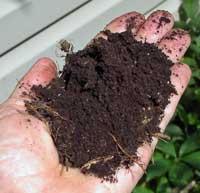|
Questioning Peat Moss
 | | Leaf humus: a good substitute for peat moss. It can be easily created at home and it's free! |
Peat moss is often recommended as a soil conditioner. It's commonly sold and in large quantities.
But a number of organizations are now questioning the use of peat moss and ask you to consider the environmental costs of using it.
The Royal Horticultural Society says peatlands are important for four reasons:
1) They're a unique natural habitat supporting biodiversity.
2) They're an important carbon sink and contain one-third of the world's soil carbon. The world's peat bogs store more carbon than all the trees in the world. But this carbon is released into the atmosphere when it is mined, and additional carbon is released by the mining process itself.
3) They contain vital geochemical and paleontological records.
4) They contain 10% of global freshwater resources and help maintain water quality and quantity--an increasingly important issue in the coming years.
On the other hand, some organizations suggest that conservative use of peat moss is fine since the industry is "regulated" and attempts to keep peat a sustainable resource.
But how can a resource that forms in bogs, marshes, and swamps over many millennia, often gaining less than a millimeter in depth every year be used sustainably?
Some organizations suggest that wetlands are restored after mining, but some wetland scientists say a managed bog lacks the biodiversity of the original bog.
As with most environmental issues, it's far cheaper to preserve than to restore.
Read a Feb. 2011 Organic Gardening article...
Read Garden Rant: The Real Dirt on Peat Moss...
Read The Royal Horticultural Society...
|
 | | Designing Gardens with Flora of the American East by Carolyn Summers |
Will we be a positive force?
We are part of the natural world around us, and we can be a positive force as well as a negative one.
If, however we see ourselves as apart from nature, or above nature, we will fail to act or fail to act responsibly.
If we remove top predators from ecosystems and either do not take their place or fail to reintroduce top predators, forested landscapes will crash.
If we strip-mine indigenous vegetation, dump it on the compost pile, and replace it with nonindigenous vegetation that supports nothing but our overdeveloped sense of aesthetics, bird and butterfly populations will crash. If we do not control the biological pollution we have unleashed, even our carefully preserved landscapes will disappear under a mass of twisted vines.
The choice is ours... By making the switch from nonindigenous to indigenous plants we can literally reconnect the landscape with its inhabitants...
As we expand our gardening habits to include stewardship of our surrounding natural areas through the thoughtful planting of indigenous plants in our own gardens, we may bask in the knowledge that it is possible to have loads of fun at the same time we are making a better world.
~ Carolyn Summers, from Designing Gardens with Flora of the American East (Afterward)
Don't miss our April 2 workshop with Carolyn Summers. Save the date, and be watching for registration information.
|